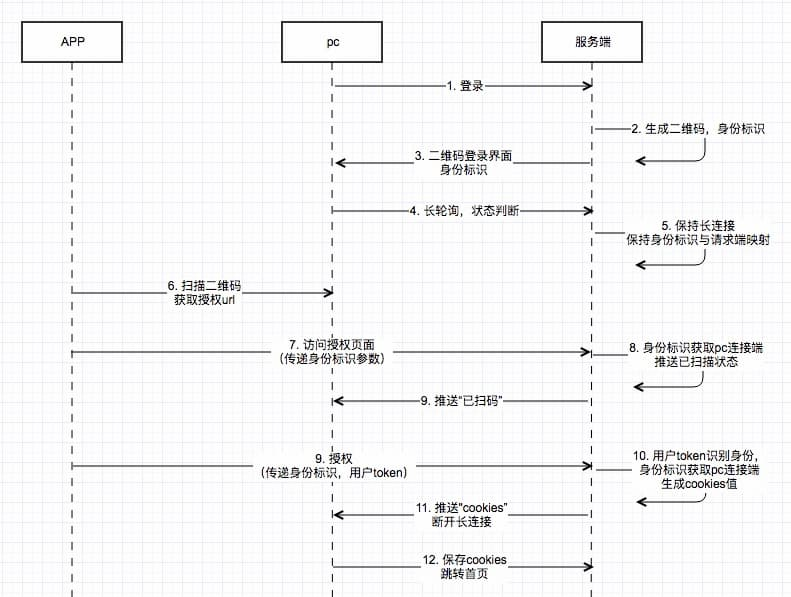本篇示例工程,主要用到以下技术栈
qrcode-plugin:开源二维码生成工具包,项目链接:https://github.com/liuyueyi/quick-mediaSpringBoot:项目基本环境thymeleaf:页面渲染引擎SSE/异步请求:服务端推送事件js: 原生 js 的基本操作
I. 原理解析
1. 场景描述
为了照顾可能对扫码登录不太了解的同学,这里简单的介绍一下它到底是个啥
一般来说,扫码登录,涉及两端,三个步骤
- pc 端,登录某个网站,这个网站的登录方式和传统的用户名/密码(手机号/验证码)不一样,显示的是一个二维码
- app 端,用这个网站的 app,首先确保你是登录的状态,然后扫描二维码,弹出一个登录授权的页面,点击授权
- pc 端登录成功,自动跳转到首页
2. 原理与流程简述
整个系统的设计中,最核心的一点就是手机端扫码之后,pc 登录成功,这个是什么原理呢?
- 我们假定 app 与后端通过 token 进行身份标识
- app 扫码授权,并传递 token 给后端,后端根据 token 可以确定是谁在 pc 端发起登录请求
- 后端将登录成功状态写回给 pc 请求者并跳转首页(这里相当于一般的用户登录成功之后的流程,可以选择 session、cookie 或者 jwt)
借助上面的原理,进行逐步的要点分析
pc 登录,生成二维码
- 二维码要求唯一,并绑定请求端身份(否则假定两个人的二维码一致,一个人扫码登录了,另外一个岂不是也登录了?)
- 客户端与服务端保持连接,以便收到后续的登录成功并调首页的事件(可以选择方案比较多,如轮询,长连接推送)
app 扫码,授权登录
- 扫码之后,跳转授权页面(所以二维码对应的应该是一个 url)
- 授权(身份确定,将身份信息与 pc 请求端绑定,并跳转首页)
最终我们选定的业务流程关系如下图:

II. 实现
接下来进入项目开发阶段,针对上面的流程图进行逐一的实现
1. 项目环境
首先常见一个 SpringBoot 工程项目,选择版本2.2.1.RELEASE
pom 依赖如下
1 | <parent> |
关键依赖说明
qrcode-plugin: 不是我吹,这可能是 java 端最好用、最灵活、还支持生成各种酷炫二维码的工具包,目前最新版本2.2,在引入依赖的时候,请指定仓库地址https://raw.githubusercontent.com/liuyueyi/maven-repository/master/repositoryspring-boot-starter-thymeleaf: 我们选择的模板渲染引擎,这里并没有采用前后端分离,一个项目包含所有的功能点
配置文件application.yml
1 | server: |
获取本机 ip
提供一个获取本机 ip 的工具类,避免硬编码 url,导致不通用
1 | import java.net.*; |
2. 登录接口
@CrossOrigin注解来支持跨域,因为后续我们测试的时候用localhost来访问登录界面;但是sse注册是用的本机 ip,所以会有跨域问题,实际的项目中可能并不存在这个问题
登录页逻辑,访问之后返回的一张二维码,二维码内容为登录授权 url
1 |
|
请注意上面的实现,我们返回的是一个视图,并传递了三个数据
- redirect: 跳转 url(app 授权之后,跳转的页面)
- subscribe: 订阅 url(用户会访问这个 url,开启长连接,接收服务端推送的扫码、登录事件)
- qrcode: base64 格式的二维码图片
注意:subscribe和qrcode都用到了全局唯一 id,后面的操作中,这个参数很重要
接着时候对应的 html 页面,在resources/templates文件下,新增文件login.html
1 |
|
请注意上面的 html 实现,id 为 state 这个标签默认是不可见的;通过EventSource来实现 SSE(优点是实时且自带重试功能),并针对返回的结果进行了格式定义
- 若接收到服务端
scan消息,则修改 state 标签文案,并设置为可见 - 若接收到服务端
login#cookie格式数据,表示登录成功,#后面的为 cookie,设置本地 cookie,然后重定向到主页,并关闭长连接
其次在 script 标签中,如果需要访问传递的参数,请注意下面两点
- 需要在 script 标签上添加
th:inline="javascript" [[${}]]获取传递参数
3. sse 接口
前面登录的接口中,返回了一个sse的注册接口,客户端在访问登录页时,会访问这个接口,按照我们前面的 sse 教程文档,可以如下实现
1 | private Map<String, SseEmitter> cache = new ConcurrentHashMap<>(); |
4. 扫码接口
接下来就是扫描二维码进入授权页面的接口了,这个逻辑就比较简单了
1 |
|
用户扫码访问这个页面之后,会根据传过来的 id,定位对应的 pc 客户端,然后发送一个scan的信息
授权页面简单一点实现,加一个授权的超链就好,然后根据实际的情况补上用户 token(由于并没有独立的 app 和用户体系,所以下面作为演示,就随机生成一个 token 来替代)
1 |
|
5. 授权接口
点击上面的授权超链之后,就表示登录成功了,我们后端的实现如下
1 |
|
6. 首页
用户授权成功之后,就会自动跳转到首页了,我们在首页就简单一点,搞一个欢迎的文案即可
1 |
|
7. 实测
到此一个完整的登录授权已经完成,可以进行实际操作演练了,下面是一个完整的演示截图(虽然我并没有真的用 app 进行扫描登录,而是识别二维码地址,在浏览器中进行授权,实际并不影响整个过程,你用二维扫一扫授权效果也是一样的)
请注意上面截图的几个关键点
- 扫码之后,登录界面二维码下面会显示已扫描的文案
- 授权成功之后,登录界面会主动跳转到首页,并显示欢迎 xxx,而
且注意用户是一致的
8. 小结
实际的业务开发选择的方案可能和本文提出的并不太一样,也可能存在更优雅的实现方式(请有这方面经验的大佬布道一下),本文仅作为一个参考,不代表标准,不表示完全准确,如果把大家带入坑了,请留言(当然我是不会负责的 🙃)
上面演示了徒手撸了一个二维码登录的示例工程,主要用到了一下技术点
qrcode-plugin:生成二维码,再次强烈安利一个私以为 java 生态下最好用二维码生成工具包 github.com/liuyueyi/qu… (虽然吹得比较凶,但我并没有收广告费,因为这也是我写的 😂)SSE: 服务端推送事件,服务端单通道通信,实现消息推送SpringBoot/Thymeleaf: 演示项目基础环境


